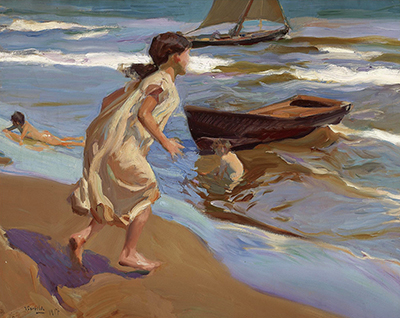Joaquin Sorolla produced a number of paintings in the 1910s with the same title of The Bathing Hour. Here we find one example of that, with the precise year of its inception believed to be 1917.
The composition features the same beaches as found in many of this artist's paintings, and so is presumably set in Valencia, which is where Sorolla grew up. His colour scheme here of whites and blue for the sea and waves, with a brownish yellow tinge for the sand is repeated many times over, with the main variation each time being the figures used. In this case we find several young children playing in the sea, with a taller, older girl running from the shore towards the water. There is a simple wooden boat beached on the shore, with a more impressive sailing boat just off in the distance. The artist creates a feeling of drama and excitement in how he poses the girl nearest us, as she leans forwards, desparate to enter the lapping waves. She also sees the other children thoroughly enjoying this connection to the power of nature. The artist signs the piece in the bottom left hand corner, just below the shadow cast by the main figure of this composition.
Sorolla loved to focus on the lives of local people in and around the Valencian coast, be it the children found here or fishermen and women going about their working lives. He would have become very comfortable in capturing his natural surroundings because of the number of portraits that he produced within this environment, leaving him to just focus on the particular variations of each piece, which would be the specific portraits, as well as potentially some different types of vessels. Most of these scenes would be bright in colour and outlook, but sometimes his work could be more sombre, such as with And They Still Say Fish are Expensive!, for example, where a young sailor has been injured whilst abroad a fishing vessel. Sorolla returned to his native city of Valencia many times, never losing his deep affection for this region which is located on the east coast of Spain.
Sorolla was described as the true master of light by French Impressionist, Claude Monet. The Valencian may have received greater respect from the public if he had been a part of the Paris-based group, which would have naturally exposed his work to many more people. For example, a number of artists receive interest by those who first study the work of Monet, before then discovering related names such as Morisot, Cassatt and Bazille, for example. Sorolla was independent of all of these, although he did share friendships with some other notable artists, such as Singer Sargent and Childe Hassam. That perhaps explains how his work also became well known within the US, as well as his native Spain, but he did not receive quite the same adulation in the UK by contrast. His awards helped to earn his respect with academics, and it seems that in the present day he is now far more well known internationally than he was during his own lifetime.




